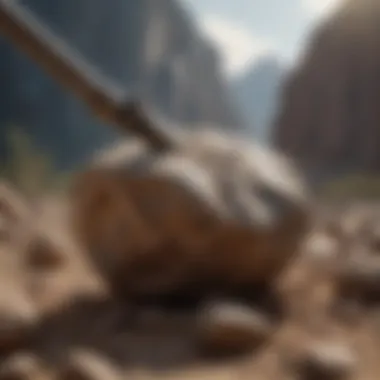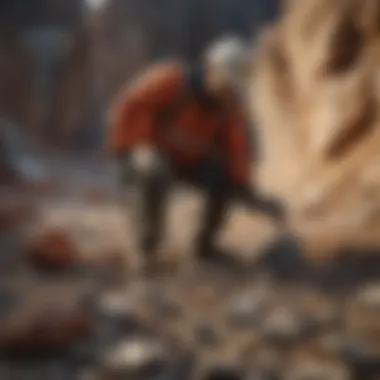Unveiling the Rock Breaking Hammer: Geology's Revolutionary Tool


Rock and Fossil Identification
Rock and fossil identification is a crucial aspect of rock collecting, requiring a keen eye and knowledge of key characteristics. Various types of rocks and fossils exist in the Earth's diverse geological makeup, each exhibiting distinct features that aid in their recognition. When engaging in rock collecting, it is essential to understand the different types of rocks and fossils, such as sedimentary, metamorphic, and igneous varieties. By familiarizing yourself with the unique characteristics of each type, from color and texture to mineral composition, collectors can efficiently identify and classify their findings. Utilizing specialized tools, such as magnifying lenses and hardness testing kits, enhances the identification process by offering precise details for accurate classification.
Introduction
In the realm of rock collecting, the foundational tool that reigns supreme is the rock breaking hammer. This article is a deep dive into the transformative power of the rock breaking hammer, shedding light on its pivotal role in revolutionizing the way enthusiasts approach their collections. A careful exploration of this tool unearths hidden geological treasures, making it an indispensable companion for passionate rock and fossil collectors striving to unearth nature's secrets.
Understanding the Significance of Rock Breaking Hammers
Evolution of Rock Breaking Tools
The evolution of rock breaking tools marks a significant advancement in the field of geological exploration. With meticulous craftsmanship and innovative design, these tools have undergone a metamorphosis over the years, catering to the evolving needs of collectors. One key characteristic of these tools is their durability and precision, allowing collectors to effectively break through tough rock surfaces with ease. This durability ensures longevity and reliability, making them a popular choice among rock collectors who value efficiency and effectiveness.
Role in Geological Exploration
The rock breaking hammer plays a pivotal role in geological exploration by serving as the primary tool for uncovering hidden geological wonders. Its ability to provide precise strikes and consistent force application makes it a valuable asset for collectors navigating various terrains. The key characteristic of this tool lies in its versatility, allowing collectors to explore diverse landscapes with confidence. While its unique feature of sturdy construction ensures durability, collectors must also be mindful of its weight and balance to optimize their rock breaking experience.
Types of Rock Breaking Hammers
Geological Hammers
Geological hammers stand out for their specialized design tailored to the demands of intense rock breaking activities. These hammers boast a key characteristic of rugged durability, making them a preferred choice for collectors engaging in challenging fieldwork. Their unique feature lies in their comfortable grip and precise striking surface, offering collectors enhanced control and efficiency. While their advantages include reliability and effectiveness, collectors must also consider potential drawbacks such as weight and maneuverability.
Crack Hammers
Crack hammers are renowned for their ability to break through tough geological formations with precision and ease. Their key characteristic lies in their pointed tip, which is ideal for targeting specific weak points in rocks. This feature enables collectors to extract delicate specimens without causing unwanted damage. While crack hammers excel in their ability to split rocks cleanly, collectors may encounter limitations in terms of force application and versatility.


Chisel-edged Hammers
Chisel-edged hammers offer a unique approach to rock breaking, featuring a sharp, chisel-like edge for precise carving and splitting. Their key characteristic lies in their intricate design, which allows for intricate detailing and controlled breaks. This feature makes them a popular choice for collectors looking to extract delicate specimens with minimal damage. While their advantages include precision and finesse, collectors should be cautious of potential disadvantages such as reduced force application in comparison to other types of hammers.
Choosing the Right Hammer for Your Collection
Material Composition
The material composition of a rock breaking hammer significantly influences its performance and durability in the field. Selecting a hammer crafted from high-quality steel or titanium ensures robustness and resistance to wear and tear. This key characteristic makes it a preferred choice for collectors seeking longevity and reliability in their tools. The unique feature of these materials is their lightweight yet sturdy nature, offering collectors a balanced and efficient hammer for their collection pursuits.
Weight and Balance
Optimal weight and balance are crucial considerations when choosing a rock breaking hammer, as they directly impact the user's comfort and control during operation. A well-balanced hammer reduces fatigue and enhances accuracy, making it easier for collectors to strike with precision. The key characteristic of weight distribution ensures that the hammer feels natural in hand, promoting efficient and ergonomic use. While the advantage of a balanced hammer lies in improved handling, collectors should be wary of potential disadvantages related to weight and maneuverability based on their individual preferences.
Ergonomic Design
The ergonomic design of a rock breaking hammer is essential for promoting comfort and efficiency during collection endeavors. Hammers with ergonomic handles and grips reduce strain on the user's hands and wrists, allowing for prolonged use without discomfort. The key characteristic of ergonomic design lies in its user-centered approach, prioritizing ease of handling and minimizing the risk of repetitive strain injuries. The unique feature of ergonomic hammers is their adaptability to various hand sizes and preferences, catering to a wide range of collectors seeking a personalized and ergonomic tool for their rock collecting escapades.
Techniques for Effective Rock Breaking
Rock breaking is a precise science that requires a deep understanding of techniques to extract valuable geological specimens efficiently. In this article, we delve into the essential aspects of mastering rock breaking to revolutionize the collection process. One of the key elements in effective rock breaking is the ability to deliver precision strikes, ensuring the targeted rock's seamless fragmentation. By implementing the right techniques, collectors can maximize their yield and uncover hidden geological wonders. Consistent force application plays a pivotal role in breaking rocks effectively, as it prevents shattering and preserves the integrity of the specimen. Understanding and honing these techniques are fundamental in elevating the rock collecting experience to new heights.
Precision Strikes
Precision strikes are a fundamental component of rock breaking, enabling collectors to pinpoint weak points in the rock's structure for optimal fracturing. Targeting weak points requires a keen eye and a strategic approach to ensure controlled and precise fragmentation. This technique is highly beneficial as it minimizes unnecessary damage to the specimen, allowing collectors to retain the integrity of the extracted rocks. The unique characteristic of targeting weak points lies in its ability to maximize the efficiency of the breaking process, resulting in a higher success rate of extracting intact specimens.
Consistent Force Application


Consistent force application is paramount in rock breaking, as it involves maintaining a steady level of pressure throughout the striking process. This technique ensures uniform fragmentation and prevents the rock from fracturing unpredictably. By exerting consistent force, collectors can control the breakage pattern and extract desired specimens with precision. The key feature of consistent force application is its ability to maintain stability and avoid excessive damage to the specimen. While this technique requires practice and skill to master, its advantages in terms of preserving specimen quality are unmatched in the realm of effective rock breaking.
Utilizing Protective Gear
Rock breaking can be a hazardous activity, necessitating the use of appropriate protective gear to safeguard collectors from potential injuries. Safety goggles are essential in shielding the eyes from flying debris and dust during the breaking process. Their key characteristic lies in providing clear vision while ensuring protection, making them a popular choice for rock collectors. Additionally, gloves play a crucial role in protecting the hands from rough surfaces and sharp edges, enhancing grip and minimizing the risk of cuts and abrasions. The unique feature of gloves is their versatility, offering both comfort and dexterity to collectors during rock breaking activities. Safety boots are another vital component of protective gear, providing stability and impact resistance to prevent foot injuries. Their key characteristic of durability and traction makes them a beneficial choice for rock collectors operating in rocky terrain.
Proper Handling and Maintenance of the Hammer
Efficient rock breaking extends beyond techniques to encompass proper handling and maintenance of the rock breaking hammer. Cleaning and rust prevention are essential aspects of hammer maintenance, ensuring its longevity and optimal performance. By regularly cleaning the hammer and applying rust prevention measures, collectors can extend its lifespan and maintain its efficacy. Storage practices are equally crucial in preserving the hammer's quality, preventing damage and ensuring easy accessibility. Proper storage in a dry and secure environment mitigates the risk of corrosion and accidental damage, enhancing the hammer's durability and functionality.
Safety Measures and Precautions
Safety measures and precautions are paramount when it comes to handling rock breaking hammers in the field of rock collecting. These measures ensure the safety of both collectors and the surrounding environment, allowing for a fruitful and secure rock collecting experience. By adhering to proper safety protocols, enthusiasts can avoid potential injuries and environmental damage.
Ensuring Personal Safety
Proper Stance and Posture
Proper stance and posture play a crucial role in maintaining personal safety while using rock breaking hammers. Adopting the correct posture minimizes the risk of strain or injury to the body, especially with repetitive hammer strikes. The key characteristic of proper stance and posture is its ability to distribute force evenly, reducing impact on specific muscle groups. This ergonomic choice promotes longevity in rock collecting sessions, enhancing efficiency and reducing the likelihood of fatigue. While maintaining proper stance and posture, collectors benefit from increased precision and accuracy in their hammer strikes due to improved body alignment and positioning.
Combatting overexertion is a challenge in rock collecting, but with the right posture and stance, enthusiasts can mitigate the risks associated with muscle strain and fatigue. By emphasizing a neutral spine position and distributing weight evenly, collectors can ensure that their bodies are better equipped to withstand the physical demands of using rock breaking hammers. Embracing proper stance and posture not only enhances safety but also optimizes the overall collecting efficiency and experience, enabling enthusiasts to focus on uncovering geological wonders without compromising their well-being.
Avoiding Overexertion
Overexertion is a common concern for rock collectors, as the repetitive nature of hammer strikes can lead to muscle fatigue and strain. Avoiding overexertion involves recognizing personal physical limits and pacing oneself during collecting sessions. The key characteristic of this approach is to prevent undue stress on muscles and joints by incorporating rest periods and adjusting the intensity of hammer strikes accordingly. By listening to their bodies and implementing moderation, collectors can prevent overexertion-related injuries and ensure a sustainable rock collecting practice.
When it comes to avoiding overexertion, moderation is the guiding principle. Balancing the intensity of hammer strikes with adequate rest breaks allows collectors to maintain a steady rhythm while safeguarding their physical well-being. Embracing this approach not only prevents injuries but also cultivates a mindful collecting practice that prioritizes long-term health and enjoyment in rock collecting activities.


Protecting the Surrounding Environment
Minimizing Noise Pollution
Minimizing noise pollution is essential in preserving the tranquility of natural environments where rock collecting takes place. Excessive noise can disturb wildlife, disrupt ecosystems, and detract from the overall experience of collectors and other nature enthusiasts. The key characteristic of noise pollution minimization is the conscious effort to control the sound levels generated during rock-breaking activities by utilizing noise-dampening tools or techniques. This proactive approach not only benefits the immediate surroundings but also fosters a harmonious coexistence between collectors and nature.
Respecting natural habitats is a fundamental principle in ethical rock collecting practices, as it ensures the preservation of delicate ecosystems and wildlife populations. By minimizing their impact on the environment, collectors can contribute to the conservation of geological treasures for future generations to appreciate. The key characteristic of this practice is the harmonious coexistence with the natural surroundings through conscientious actions and responsible behaviors. By prioritizing environmental respect, collectors can partake in their hobby with a clear conscience, knowing that they are safeguarding the ecological balance of the areas they explore.
Enhancing Your Rock Collecting Experience
Enhancing Your Rock Collecting Experience is a pivotal aspect of this article, focusing on elevating the journey of rock and fossil collectors. In this section, we delve into key elements that enrich the collecting experience, considering factors that enhance both the enjoyment and depth of the exploration.
Incorporating Technology
Digital Mapping Tools
Digital Mapping Tools play a crucial role in modernizing the rock collecting experience. These tools provide detailed geographic information, allowing collectors to pinpoint specific locations with geological significance. The key characteristic of Digital Mapping Tools lies in their ability to create accurate digital representations of landscapes, aiding collectors in planning efficient expeditions. The unique feature of Digital Mapping Tools is their real-time updating capability, giving collectors access to the latest data. While advantageous in aiding navigation and exploration, some limitations include potential inaccuracies in remote areas with limited digital mapping coverage.
3D Scanning Technologies
3D Scanning Technologies revolutionize how collectors interact with their finds. By capturing detailed three-dimensional models, collectors can study specimens virtually, preserving them digitally for further analysis. The key characteristic of 3D Scanning lies in its ability to create high-fidelity replicas that enhance scientific study and educational purposes. The unique feature of 3D Scanning is its non-invasive nature, allowing collectors to archive fragile specimens without risk of damage. Despite its benefits in documentation and analysis, challenges may arise in capturing intricate details of irregularly shaped rocks or fossils.
Collaborating with Experts
In the realm of rock collecting, collaborating with experts offers a wealth of knowledge and expertise to enthusiasts seeking to deepen their understanding. Geologists bring scientific insight into rock formation and mineral composition, guiding collectors in identifying unique specimens. Their key characteristic lies in interpreting geological processes, shedding light on the history embedded in each find. While collaborating with geologists enhances the educational value of collections, challenges may arise in accessing specialized geological knowledge or interpretation complexities.
Within the field of paleontology, Paleontologists provide invaluable expertise in identifying, dating, and contextualizing fossils. Their key characteristic lies in unraveling the evolutionary history preserved in each fossil, offering narratives of ancient life forms. The unique feature of Paleontologists is their ability to reconstruct prehistoric environments based on fossil evidence, enriching collectors' understanding of earth's past. However, limitations may exist in engaging with scarce paleontologists or interpreting fragmented fossil records.
Joining Rock Collecting Communities
Being part of rock collecting communities amplifies the enthusiast's experience by fostering connections with like-minded individuals. Online Forums serve as virtual hubs where collectors share discoveries, techniques, and insights. The key characteristic of Online Forums is the vast pool of collective knowledge and experiences, offering a platform for learning and discussion. Meanwhile, overcoming language barriers or moderating conflicting opinions may represent challenges within online forums.
For those seeking local engagement, joining Local Clubs provides opportunities for in-person interactions, field trips, and hands-on learning. The key characteristic of Local Clubs is their role in building a sense of community and camaraderie among collectors in the same region. Embracing diversity within clubs can enhance the learning experience, although logistical constraints or limited club availability could pose challenges in certain areas.







